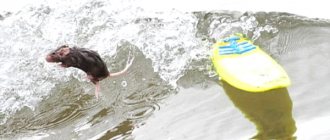The hamster is one of the cutest and friendliest pets. The hilarious behavior of this animal, its funny face and beautiful fur evoke affection in both children and adults.
Those who decide to have a rodent in their home need to study the rules for caring for it in advance. One of the key questions is how to wash a hamster?
Actually, I’m white... Well, that’s how it happened!
Is it possible to bathe a hamster in water?
In most pet stores you can find two breeds of hamsters: Djungarians and Syrians. The rules for caring for them are slightly different, but in general their physiology is similar. Both the former and the latter have natural habitats that are steppes and deserts. Such living conditions have taught small rodents to be very clean; they clean their fur 5–6 times a day, which is why they look neat, even if they are not washed.
Due to their existence in an arid climate, rodents do not tolerate water treatments well:
- Their fur is very thin, making them sensitive to cold water.
- If the water is too hot, your pet may have a heart attack.
- Hamsters can swim, but poorly. Without reaching the bottom, the rodent may panic and drown.
So, back to our question: is it possible to bathe hamsters? It is undesirable to do this, since this is serious stress for the small body of a rodent. However, there is no need for regular bathing, since the animal carefully observes hygiene.
Necessary components for washing
- A bowl
The hamster needs a bath for bathing. It should not have too high sides - a height of 3-4 centimeters will be enough. This could be, for example, a food container. The sink is not suitable for swimming, as its coating is slippery. In addition, it itself is cold and you will have to spend too much time heating it. Due to temperature changes, a hamster can get pneumonia.
- Available means
For directly washing the animal, items that can be found in any home are suitable: a soft toothbrush to comb the hamster’s fur, if necessary, and cotton pads for a delicate face.
- Shampoo without fragrance
Detergents should be used only when absolutely necessary: if you need to get rid of greasy or sticky residue. You should buy fragrance-free shampoo for rodents. Products cannot be used for humans, since hamsters have a different pH value.
- Hand towel, pet cloth, paper towels
After completing the procedure, you should carefully dry your pet. The fabric of the cloth is not important, but it is desirable that it absorbs water well.
- Delicacy
To reward your pet for enduring the procedure, you can treat him with his favorite treat. This could be, for example, fruit or some greens.
- Assistant
It would be very good if you had another person helping you, because it will not be easy to bathe the hamster on your own.
In what cases is bathing a rodent justified?
Djungarian and Syrian hamsters are very freedom-loving and need constant physical activity. They cannot be kept in a cage all the time, otherwise they will become unsociable and may start to get sick. Therefore, rodents often run around the house and, when left to their own devices, can get dirty.
One of the most common problems with bathing a hamster is food contamination. The fact is that there is a whole list of substances that can cause allergies or poisoning in your pet. And since he regularly licks his fur, whatever he smeared himself in will certainly end up in his mouth. So, bathing is justified if the hamster gets into:
- Jam.
- Oil.
- Honey.
In general, any sticky and viscous products can be added to this list, since it will not be possible to clean the wool in any way other than washing.
Of course, I'm not a pig, but I will find dirt.
A more dangerous situation is when toxic products get on the animal’s body. Bleach, disinfectants, acetone and other chemicals cause serious damage to fur. And if such substances enter the body when the pet washes itself, it can lead to death.
Another reason to bathe your hamster is heavy contamination of the fur with droppings and urine. But this situation is out of the ordinary and only the owner is to blame for it, who does not sufficiently monitor the conditions in which the pet lives. To avoid this, you need to regularly clean the hamster's cage, wash it, and do not forget to change the bedding.
Residents of Vietnam are prohibited from keeping their houses
Vietnamese legislation has a clause according to which it is prohibited to privately keep and breed hamsters as pets, since they are carriers of many infectious diseases, including tuberculosis, a very important disease for developing countries. Violation of this law will result in a substantial fine.
Important! Hamsters are carriers of about 30 infectious diseases, some of which are fatal to humans. If swelling appears in the bite area and temperature, you should immediately seek medical help.
If a hamster has had contact with street dogs, becomes lethargic after aggression, and then dies, then the animal should be examined for rabies.
The bite of wild hamsters is mainly dangerous, but the bite of a pet should also be washed and disinfected.
What to pay attention to before swimming?
To avoid causing physical harm and to avoid severe stress, follow these bathing rules:
- Heat the water to 30 – 35 degrees before washing your hamster. If it is colder, the pet may catch a cold; hot - get a heart attack.
- Be careful not to get water into your eyes or ears.
- Prepare a towel and hairdryer in advance. After the bath, the animal needs to be dried as quickly as possible, otherwise it may get sick.
Important: under no circumstances should you use regular soap or shampoo. A hamster can only be washed with a special detergent sold in pet stores (if you can’t find one for a hamster, buy one for a rabbit or rodent - it’s also suitable). This is due to the fact that the acid-base balance of human and rodent skin is different. Because of this, when using the wrong shampoo, the rodent’s protective fat layer is disrupted, which leads to dermatitis and scratching, in place of which purulent wounds form.
This cannot be used. Buy your hamster a special shampoo.
When to wash a rat and when not to
Although it is not necessary to wash the rodent, in some cases it is necessary to clean the rat's fur yourself. So, when should you carry out water treatments for a rodent?
The procedure may be needed if your rat:
- something sticky in the wool;
- wool in a toxic substance such as varnish or paint;
- a skin condition that requires a veterinarian-prescribed medicated shampoo (such as mite infestation or bacterial/fungal infections).
In other cases, washing the rat is not necessary, since it is able to clean its fur on its own. However, it is strictly forbidden to wash a rat if there are certain diseases or weather conditions.
You should not wash your rat if it has the following problems:
- wounds on the body, since upon contact with water and steaming they can become inflamed;
- the rat has a cold or has recently recovered. Water procedures can cause complications or a long recovery for your pet.
How to bathe hamsters at home?
Let's move on to the instructions on how to bathe hamsters. The recommendations are relevant for both Djungarians and Syrians and other breeds:
- You need to prepare a bowl that will serve as a bath. Some bathe in the sink, but this is not the best option - water can get into the pet's ears or eyes.
- Heat the water to 30 - 35 degrees.
- Place your pet in the container and begin to wash it slowly, pouring warm water over it.
- Apply a special detergent and process the coat, avoiding the ears and eyes.
- Wash the body thoroughly and dry the rodent with a towel or napkin (or better yet, get wet).
While your pet is bathing, maintain a dialogue with him. The sound of a familiar voice will help him endure water procedures more easily. Be prepared for the fact that while washing the animal may start squeaking and biting. In this case, it is better to stop washing and try after a while when it calms down.
And now we’ll tell you in more detail about how to wash the Dzungarian and Syrian.
Don't forget to dry the baby thoroughly.
Features of bathing Djungarian hamsters
Experts do not give a clear answer to the question of whether it is possible to bathe a Djungarian hamster in water. Most veterinarians agree that washing can only be done if the dirt cannot be removed in any other way. Some people believe that bathing is also acceptable if there are parasites in your pet's fur.
The answer to the question of how to wash Djungarian hamsters is given in the instructions above. In addition, let's say that you can only pick up a rodent with your hands. At the same time, this must be done very carefully, since Djungarian hamsters are very sensitive to touch, like any other breed. If you squeeze your pet too hard, you can damage its internal organs.
Bathing a Djungarian hamster, compared to bathing a Syrian hamster, is a simpler procedure. This is due to the following reasons:
- Djungarians react more calmly to being washed. Some of them even like bath treatments.
- They have short fur, which you can quickly and easily dry with a towel or napkin.
- They have better immunity, so catching a cold after swimming is less likely.
I know how to swim, but I don’t want to, honestly.
Features of bathing a Syrian hamster
Syrian hamsters are very finicky and require more care during and after bathing. A few tips to help minimize discomfort for your pet:
- You need to wash your Syrian hamster very quickly. Swimming is not an option for him - he will definitely get sick.
- Upon completion of the procedures, dry the wool with a hairdryer on low setting. Do this only if you are sure that the rodent will not be scared by the noise.
- On the way to the crate, wrap your pet in a towel, even if the fur is dry. This is necessary for his body to warm up to its usual temperature.
Tip: To reduce stress for your pet, use food rewards in the form of treats that he loves. This will help keep it on your hands longer while drying.
I won’t smear myself, I swear by my hamster mother!
Description and appearance
Djungarian hamsters are funny and attractive rodents with a pointed muzzle and small ears. The average body length of a fully adult individual, regardless of gender, reaches 9-10 cm with a body weight in the range of 35-65 grams. Quite thick hairs cover the digital tubercles. The belly area of a domestic rodent is characterized by a light color, and the back has an ocher-gray or brown-gray color.
The paws and inside of the ears of the Djungarian hamster are white. A specific feature is the presence of a narrow black stripe running along the entire ridge of the hamster. Djungarians are characterized by increased activity at night, and the minks of such animals are represented by a nesting chamber, several holes and entrances.
In summer, wild individuals have a predominant grayish coat color, and in winter, the coat acquires a very characteristic, silvery-white hue.
It is important to note that domesticated Djungarian hamsters very often have quite striking differences in color from their wild relatives. Currently, rodents with several types of fur colors are kept at home, but the most popular are pets with the following colors:
- “standard”, having a brownish-gray main hair color and a white belly;
- “sapphire”, having a grayish-bluish main hair color and a white belly;
- “pearls”, having a matte white main hair color with grayish intervals;
- “tangerine”, having a reddish-cream basic hair color.
Swimming in the sand
Since bathing Syrian hamsters is problematic, caring owners wash them in sand. Actually, in natural conditions, this is exactly how rodents wash themselves.
Advantages of this method:
- Perfectly cleanses the fur of stubborn dirt.
- It does not cause stress, but on the contrary, it gives pleasure to your pet.
- Unlike water, sand cannot harm the health of a rodent.
If you use sand, you won't have to worry about how to properly bathe your hamster without harming it. The process is simple and natural, and the pet gets nothing but pleasure from it. All you need to do:
- Pour sand into the container.
- Put it in a cage.
- Observe - the hamster will wash itself.
- After finishing bathing, remove the container, otherwise it will turn into an additional toilet.
Important: buy sand that is specifically designed for hamsters.
This is very important because this product undergoes a number of cleaning measures. Thanks to this, it is absolutely safe for the pet's health.
One more caveat: do not buy sand intended for cleaning chinchilla fur. It is too fine-grained, so it is unlikely to be able to properly clean the hamster’s fur. In addition, it can enter his respiratory tract, causing inflammation.
Natural habits
In the wild, hamsters are solitary. They build long, deep, multi-level burrows with several storerooms for winter supplies, summer and winter nests, and many entrances and exits. Rodents mark their territories and do not allow other hamsters to enter them. The animals unite only during the mating period in the female’s territory, after which the male quickly leaves her, since the female can be quite aggressive if the “suitor” lingers too long and can attack him. Only the female bears and raises the cubs.
The hamster is a nocturnal resident; during the day it sleeps and sits out in its burrow, and at dusk it goes out to hunt, has a hearty dinner, fills its cheeks with reserves for future use and transfers them to the pantry. They do not know the exact amount of supplies that will last for the whole winter, so he stuffs into his pantry exactly as much as he can before the first frost, and then goes into hibernation. On average, his “barns” store about 10 kilograms of various food items. They found storehouses of hamsters with reserves of more than 50 kg; most likely, these were the accumulations of several years of life. It is noteworthy that the animal stores different types of food separately. So in one hole you can find different types of grain: wheat, oats, buckwheat, corn, lupine, vegetables and roots - this is what the common hamster eats in long winter conditions.
The rodent carefully protects its supplies from other animals and relatives, and is capable of getting into a fight. When irritated, it stands on its hind legs, bares its strong teeth and prepares to jump. An ordinary hamster jumps well and runs quickly when escaping from an enemy, but in a calm state it moves slowly. Thanks to its activity, it can live up to 8 years.
Washing a rodent using cosmetic pads and wet wipes
In addition to classic bathing and sand, you can wash your pet using cotton pads and wet wipes. The disc is very simple to use: moisten it in water and rub it over the contaminated area with light stroking movements.
You need to use napkins the same way. But there is one important point here: they should not contain alcohol or any kind of chemical elements that can ruin the hamster’s fur and damage the skin. The ideal option is to wash with baby wipes.
As with bathing, after wiping with napkins or discs, the coat should be thoroughly dried with a towel. If this is not done, the pet may get sick.
On behalf of the entire hamster family, I express my gratitude for not throwing it into the bathtub! Or much worse...
Can hamsters swim?
It is not known why owners of tiny rodents so often wonder if hamsters can swim. Theoretically, all mammals can float on water, even those completely unsuited for this. And if no one has yet been able to check whether giraffes can swim, then with rodents and lagomorphs the question has been resolved unequivocally: they can. However, before you let your pet into the water, read this article in more detail to find out why this should not be done .
Summary
So, is it possible to wash hamsters with water? The answer is yes, but quickly, very carefully and only in extreme cases. In general, bathing procedures should be avoided, since neither the Dzungarians nor the Syrians are adapted to them (the latter in particular). To wash your hamster, use special sand from a pet store - this will almost always be enough.
Do you have any questions? Be sure to ask them in the comments, we will add the answers to the article. And subscribe to notifications about updates, otherwise you will miss a lot of interesting things!











